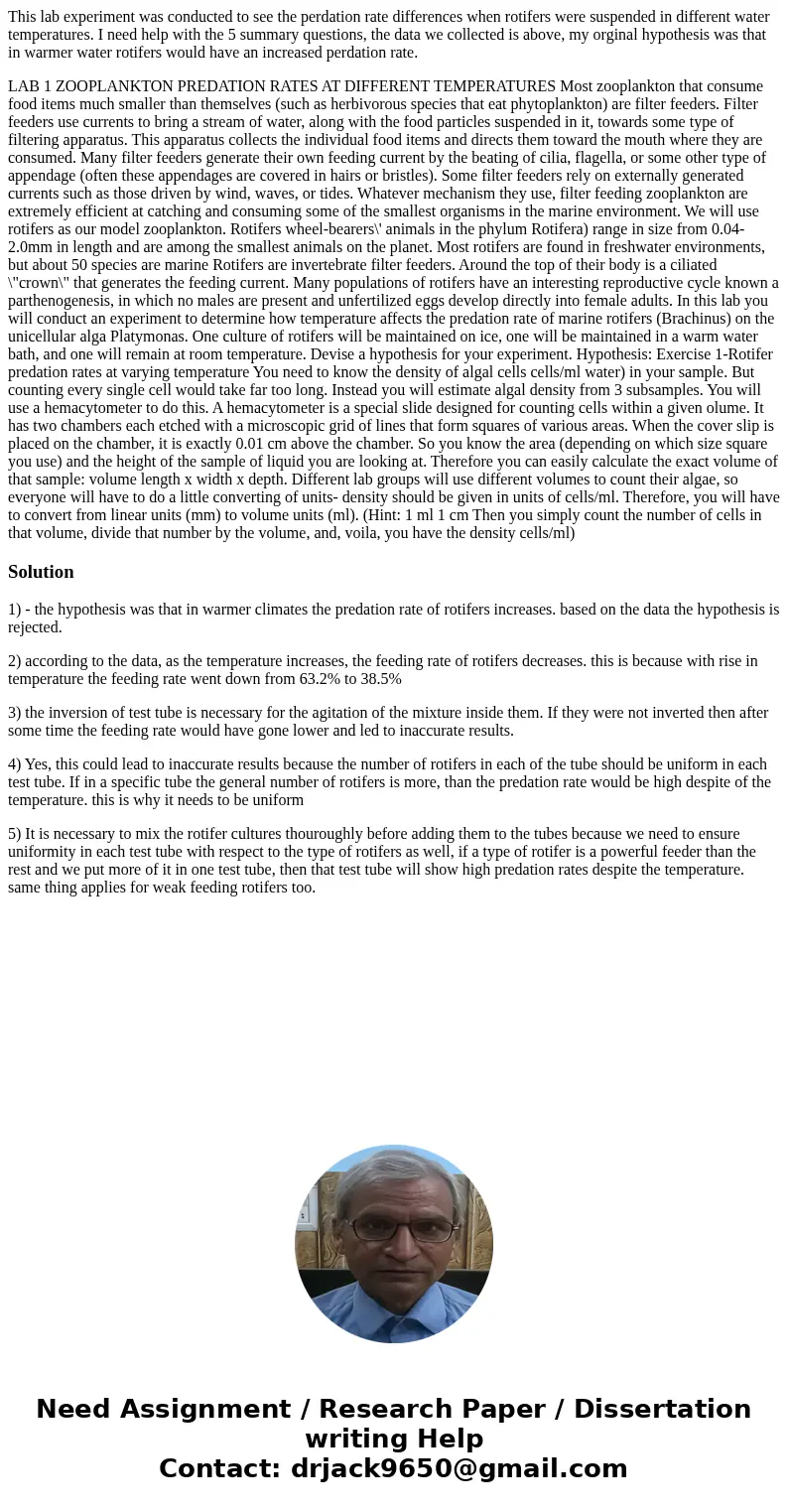This lab experiment was conducted to see the perdation rate
This lab experiment was conducted to see the perdation rate differences when rotifers were suspended in different water temperatures. I need help with the 5 summary questions, the data we collected is above, my orginal hypothesis was that in warmer water rotifers would have an increased perdation rate.
LAB 1 ZOOPLANKTON PREDATION RATES AT DIFFERENT TEMPERATURES Most zooplankton that consume food items much smaller than themselves (such as herbivorous species that eat phytoplankton) are filter feeders. Filter feeders use currents to bring a stream of water, along with the food particles suspended in it, towards some type of filtering apparatus. This apparatus collects the individual food items and directs them toward the mouth where they are consumed. Many filter feeders generate their own feeding current by the beating of cilia, flagella, or some other type of appendage (often these appendages are covered in hairs or bristles). Some filter feeders rely on externally generated currents such as those driven by wind, waves, or tides. Whatever mechanism they use, filter feeding zooplankton are extremely efficient at catching and consuming some of the smallest organisms in the marine environment. We will use rotifers as our model zooplankton. Rotifers wheel-bearers\' animals in the phylum Rotifera) range in size from 0.04-2.0mm in length and are among the smallest animals on the planet. Most rotifers are found in freshwater environments, but about 50 species are marine Rotifers are invertebrate filter feeders. Around the top of their body is a ciliated \"crown\" that generates the feeding current. Many populations of rotifers have an interesting reproductive cycle known a parthenogenesis, in which no males are present and unfertilized eggs develop directly into female adults. In this lab you will conduct an experiment to determine how temperature affects the predation rate of marine rotifers (Brachinus) on the unicellular alga Platymonas. One culture of rotifers will be maintained on ice, one will be maintained in a warm water bath, and one will remain at room temperature. Devise a hypothesis for your experiment. Hypothesis: Exercise 1-Rotifer predation rates at varying temperature You need to know the density of algal cells cells/ml water) in your sample. But counting every single cell would take far too long. Instead you will estimate algal density from 3 subsamples. You will use a hemacytometer to do this. A hemacytometer is a special slide designed for counting cells within a given olume. It has two chambers each etched with a microscopic grid of lines that form squares of various areas. When the cover slip is placed on the chamber, it is exactly 0.01 cm above the chamber. So you know the area (depending on which size square you use) and the height of the sample of liquid you are looking at. Therefore you can easily calculate the exact volume of that sample: volume length x width x depth. Different lab groups will use different volumes to count their algae, so everyone will have to do a little converting of units- density should be given in units of cells/ml. Therefore, you will have to convert from linear units (mm) to volume units (ml). (Hint: 1 ml 1 cm Then you simply count the number of cells in that volume, divide that number by the volume, and, voila, you have the density cells/ml)Solution
1) - the hypothesis was that in warmer climates the predation rate of rotifers increases. based on the data the hypothesis is rejected.
2) according to the data, as the temperature increases, the feeding rate of rotifers decreases. this is because with rise in temperature the feeding rate went down from 63.2% to 38.5%
3) the inversion of test tube is necessary for the agitation of the mixture inside them. If they were not inverted then after some time the feeding rate would have gone lower and led to inaccurate results.
4) Yes, this could lead to inaccurate results because the number of rotifers in each of the tube should be uniform in each test tube. If in a specific tube the general number of rotifers is more, than the predation rate would be high despite of the temperature. this is why it needs to be uniform
5) It is necessary to mix the rotifer cultures thouroughly before adding them to the tubes because we need to ensure uniformity in each test tube with respect to the type of rotifers as well, if a type of rotifer is a powerful feeder than the rest and we put more of it in one test tube, then that test tube will show high predation rates despite the temperature. same thing applies for weak feeding rotifers too.

 Homework Sourse
Homework Sourse